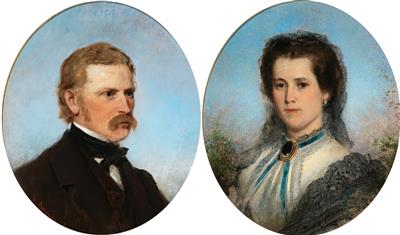Anton Romako

(Atzgersdorf 1832–1889 Vienna)
Portrait of Count Ferdinand Trauttmansdorff-Weinsberg (1825–1896) and Portrait of His Wife Marie, Née Princess von und zu Liechtenstein (1834–1909), both signed A. Romako a Roma, oil on canvas, each c. 60.5 x 50.8 cm, oval, framed
Provenance:
Private Collection Germany;
Sale, Weinmüller, Munich, 23 October 1975, lot 1413;
Private Collection Vienna.
Catalogued and illustrated in:
Cornelia Reiter, Anton Romako, Pionier und Außenseiter der Malerei des 19. Jahrhunderts, monograph and catalogue raisonné, Vienna 2010, p. 132.
Already an established artist, Anton Romako moved to Rome in the years between 1857 and 1876, where a large group of German-speaking artists had settled under the patronage of the Bavarian King Ludwig I. It is during this Roman period that Romako found his good fortune both in his private and his professional life: his marriage to Sophie Köbel helped cement his position in society and in the cultural circles of the time, furthermore he was never as commercially successful anywhere else during his lifetime.
The paintings created in the Eternal City show how the artist both adapted to prevalent tastes while also developing a unique style. The following portrait’s realism is typical for the Viennese Biedermaier, however the execution points out unmistakably to what would become characteristic of Romako’s later style, as well as to his uncanny ability to capture the personality and soul of the sitters, in this case without losing the proper sobriety required from such commissioned work.
In Rome, Romako counted among his clientele wealthy art connoisseurs and members of the European aristocracy, such as the Austrian Ambassador to the Vatican Count Ferdinand von Trauttmansdorff-Weinsberg (1825-1896) and his wife Maria Franziska, born Princess von und zu Liechtenstein (1834–1909). For Romako, it was particularly important to hold good relations with influential people in Austria, for his great ambition was to also enjoy success in his home country. Count Trauttmansdorff-Weinsberg offered his support and acted as a door-opener for Romako, thus playing an important role in the artist’s first Roman period.
Expert: Mag. Dimitra Reimüller
 Mag. Dimitra Reimüller
Mag. Dimitra Reimüller
+43-1-515 60-355
19c.paintings@dorotheum.at
09.11.2021 - 16:00
- Dosažená cena: **
-
EUR 38.852,-
- Odhadní cena:
-
EUR 35.000,- do EUR 45.000,-
Anton Romako
(Atzgersdorf 1832–1889 Vienna)
Portrait of Count Ferdinand Trauttmansdorff-Weinsberg (1825–1896) and Portrait of His Wife Marie, Née Princess von und zu Liechtenstein (1834–1909), both signed A. Romako a Roma, oil on canvas, each c. 60.5 x 50.8 cm, oval, framed
Provenance:
Private Collection Germany;
Sale, Weinmüller, Munich, 23 October 1975, lot 1413;
Private Collection Vienna.
Catalogued and illustrated in:
Cornelia Reiter, Anton Romako, Pionier und Außenseiter der Malerei des 19. Jahrhunderts, monograph and catalogue raisonné, Vienna 2010, p. 132.
Already an established artist, Anton Romako moved to Rome in the years between 1857 and 1876, where a large group of German-speaking artists had settled under the patronage of the Bavarian King Ludwig I. It is during this Roman period that Romako found his good fortune both in his private and his professional life: his marriage to Sophie Köbel helped cement his position in society and in the cultural circles of the time, furthermore he was never as commercially successful anywhere else during his lifetime.
The paintings created in the Eternal City show how the artist both adapted to prevalent tastes while also developing a unique style. The following portrait’s realism is typical for the Viennese Biedermaier, however the execution points out unmistakably to what would become characteristic of Romako’s later style, as well as to his uncanny ability to capture the personality and soul of the sitters, in this case without losing the proper sobriety required from such commissioned work.
In Rome, Romako counted among his clientele wealthy art connoisseurs and members of the European aristocracy, such as the Austrian Ambassador to the Vatican Count Ferdinand von Trauttmansdorff-Weinsberg (1825-1896) and his wife Maria Franziska, born Princess von und zu Liechtenstein (1834–1909). For Romako, it was particularly important to hold good relations with influential people in Austria, for his great ambition was to also enjoy success in his home country. Count Trauttmansdorff-Weinsberg offered his support and acted as a door-opener for Romako, thus playing an important role in the artist’s first Roman period.
Expert: Mag. Dimitra Reimüller
 Mag. Dimitra Reimüller
Mag. Dimitra Reimüller
+43-1-515 60-355
19c.paintings@dorotheum.at
|
Horká linka kupujících
Po-Pá: 10.00 - 17.00
kundendienst@dorotheum.at +43 1 515 60 200 |
| Aukce: | Obrazy 19. století |
| Typ aukce: | Sálová aukce s Live bidding |
| Datum: | 09.11.2021 - 16:00 |
| Místo konání aukce: | Wien | Palais Dorotheum |
| Prohlídka: | 29.10. - 09.11.2021 |
** Kupní cena vč. poplatku kupujícího a DPH(Země dodání Rakousko)
Není již možné podávat příkazy ke koupi přes internet. Aukce se právě připravuje resp. byla již uskutečněna.
Další objekty umělce
-

Odhadní cena:
EUR 60.000,- do EUR 100.000,- -

Odhadní cena:
EUR 18.000,- do EUR 30.000,-
Všechny objekty umělce
